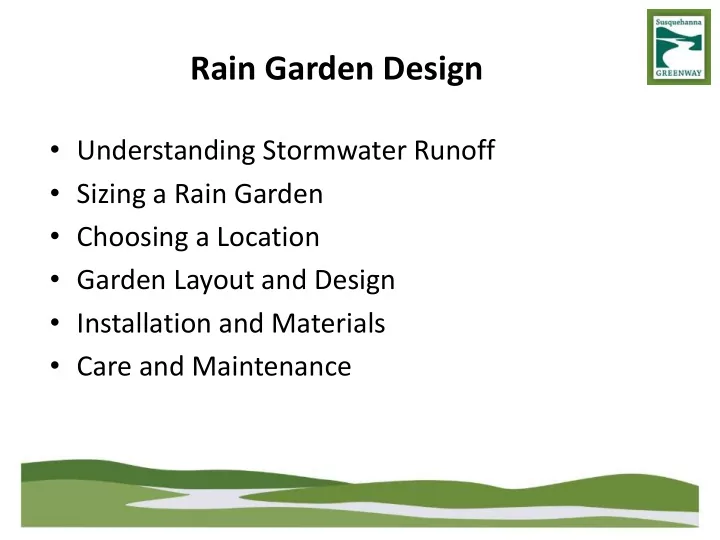

Rain Garden Design • Understanding Stormwater Runoff • Sizing a Rain Garden • Choosing a Location • Garden Layout and Design • Installation and Materials • Care and Maintenance
Stormwater Runoff
Stormwater Runoff
Rain Garden Design Stormwater Runoff is affected by… • Land Cover – paving vs. lawn vs. woodland • Soil Type and Properties • Steepness of the Land Surface • Intensity and Duration of the Storm Event
Rain Garden Design Rain Gardens are intended to capture runoff from storms producing 1” or less of rain. • the vast majority of our storms in PA are 1” or less • “First flush” = pollutants and debris washed from impervious surfaces (sediment, oils, etc.) • Provide slow release of water into soil • Remove nutrients and some pollutants
Stormwater Runoff Rain Gardens are intended to capture runoff from storms producing 1” or less of rain. • the vast majority of our storms in PA are 1” or less • “First flush” = pollutants and debris washed from impervious surfaces (sediment, oils, etc.) • Provide slow release of water into soil • Remove nutrients and some pollutants
Choosing a Location Rain Gardens – A How-to Guide for Homeowners Which impervious areas to capture?
Choosing a Location • Contact PA 1-Call at least 3 days before digging Dial 8-1-1 or 1-800-242-1776 • Check for private wiring, piping, or utilities • Keep more than 10’ from foundations • Avoid septic tank, leach field, on-site well, seasonally wet areas, and tree roots. • Gently sloped areas are preferred
Choosing a Location The Vermont Rain Garden Manual Downspouts are often connected to storm sewers, moving runoff directly to watercourses.
Sizing the Rain Garden (4 steps) The Vermont Rain Garden Manual
Sizing the Rain Garden (step 2) The Vermont Rain Garden Manual
Sizing the Rain Garden (step 2) The Vermont Rain Garden Manual
Sizing the Rain Garden (step 2) The Vermont Rain Garden Manual
Sizing the Rain Garden (step 3) The Vermont Rain Garden Manual Is there room for 3:1 side slopes?...
Sizing the Rain Garden (step 3) The Vermont Rain Garden Manual
Sizing the Rain Garden (4 steps) The Vermont Rain Garden Manual
Sizing the Rain Garden (4 steps) The Vermont Rain Garden Manual
Sizing the Rain Garden (step 3) The Vermont Rain Garden Manual 3:1 side slopes, with a level bottom
Sizing the Rain Garden (step 3) The Vermont Rain Garden Manual
Design Considerations • Shape?... kidney, tear drop, etc. • Overland flow vs. piping from downspouts – Provide erosion control/energy dissipation • Overflow considerations - grade to direct surface overflow without impacts - Avoid discharge onto neighboring properties • Provide Erosion control measures downslope
Garden Layout and Design 1. Outline perimeter using string or paint. 2. Remove grass/vegetation - Consider using black plastic as an option over pesticide
Garden Layout and Design 3a. Digging…on level ground - Level ground will be a depression below grade; dispose of soil. - Consider where water will overflow; provide a gentle dip to direct away from neighboring properties
Garden Layout and Design 3b. Digging…on sloped ground - A downslope berm must be level and compacted - Consider where water will overflow; provide a gentle dip to direct away from neighboring properties The Vermont Rain Garden Manual; adapted from Rain Gardens: A How-to annual for Homeowners, UWEX
Garden Layout and Design 4. Leveling the Bed - Dig the bed 4- 6” deeper to allow for adding soil mix & mulch - Avoid compaction; move from one side to the other or working from the center out. Avoid wet conditions. - Loosen soil if it becomes compacted. - When dug to proper depth, use a 2x4 and carpenters level to make sure the bed is level; this improves infiltration. * - Variation in the bed depth can be incorporated to provide wetter areas for diversity of plant materials. Be sure to select plants that will tolerate standing water for a longer duration for any deeper areas of your garden.
Installation and Materials 5. Improve the Soil - Adding 2” of compost or soil mix helps the soil retain moisture, and improve plant growth. (Rototilling makes this easier.) - Soil Mix: 50% topsoil, 30% sand. 20% compost 6. Plant - Layout plants, loosen root balls, and plant. - Water immediately after planting. (2 times/week until established) 7. Mulch - Apply 2- 3” of double -ground mulch to help retain soil moisture and discourage weeds.
Care and Maintenance 1. While plants establish roots and fill in, pruning and weeding may be needed. 2. Remove leaf litter twice a year – after leaf fall and before Spring growth. 3. Cut back perennials and grasses in late fall. 4. Replenish mulch for more manicured landscape areas; naturalized areas may not need this. 5. Check min. twice / year, and after major rainfall events for sediment, erosion, vegetation needs.
Rain Gardens are GARDENS with… • Managed runoff quantity for storms of 1” or less • Vegetation for evapotranspiration, soil health, pollution absorption, nutrient uptake (N,K) • A mulch layer to hold water and assist with uptake of heavy metals • Soil Biota and Pollution Reduction Properties – Physical/chemical/biological matrix for living organisms – Water cooling, infiltration and exfiltration
Residential Rain Garden Guides The Vermont Rain Garden Manual http://www.docs.dcnr.pa.gov/cs/groups/public/documents/docum ent/dcnr_20028271.pdf Rain Gardens, a how-to manual for homeowners http://dnr.wi.gov/topic/shorelandzoning/documents/rgmanual.pdf Rain Garden Alliance http://raingardenalliance.org/right
BioRetention Cells as Stormwater BMP PA Stormwater Best Management Practices Manual http://www.elibrary.dep.state.pa.us/dsweb/Get/Document- 67993/6.4.5%20BMP%20Rain%20Garden%20Bioretention.pdf BioRetention Cells/Rain Gardens, a Stormwater BMP (Penn State) https://extension.psu.edu/rain-gardens-bioretention-cells-a- stormwater-bmp
Existing Environment Invasive species: Canada thistle, crown vetch, mile- a-minute vine, Japanese stilt grass and knotweed
Existing Environment Site Slope 8% = 8” depth Silty Soil @ 8”= 0.16 size factor Drainage area= 5700 SF 5700 x 0.16 = 912 SF garden 70’ x 13’ wide = 912 SF
Existing Environment Dense plant spacing due to invasive species presence.
Existing Environment
Recommend
More recommend